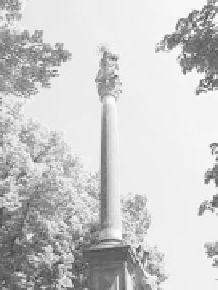Travel Reference
In-Depth Information
Near Terezín: Litoměřice
With a bustling, beautifully restored Renaissance square,
Litoměřice (lee-TOH-myer-zheet-seh, pop. 26,000)—located
three miles nor th of Terezín—is
a perfect lunch spot to lift your
spirits after the bleak ness of the
camp. During the communist era,
Litoměřice had the only seminary
in the country. Today, there are still
t wo huge Baroque churches here.
Linger on the main square, Mírové
Náměstí, and experience the life of
this friendly, untouristy Czech town.
If arriving by bus from Terezín,
get off at the f irst stop after the
bridge; from here, it's a two-minute
walk (slightly uphill) to the main square. From the square, several
small streets filled with bakeries and convenience shops radiate
outwards. The onion-shaped tower is south, and the higher part of
the square is due west. Stroll around and get lunch on the square
(see “Eating,” below). After lunch, climb up the onion-shaped
tower of the
To w n H a l l
(the guide in the tower loves to talk), but
skip the uninteresting museum on the square.
The short street next to the Town Hall leads onto the city walls,
with good views. The statue at the viewpoint depicts the Romantic
poet
Karel Hynek Mácha
(1810-1836),
who wrote the most famous Czech poem,
“Máj.” He died in Litoměřice. In 1939, his
body was ceremonially exhumed and trans-
ferred to the Slavín cemetery atop Prague's
Vyšehrad hill. Mácha became a symbol
of the irrepressible Czech spirit, stirring
Czech nationalism during the occupations
of the Nazis f irst, then the communists
after. In November 1989, demonstrat-
ing students were headed for the grave of
Mácha, when they suddenly decided that
they were tired of the communists...and
thus started the Velvet Revolution.
e ati ng
The most convenient spot is the Czech fast-food joint
Joka,
which
serves standard ready-to-eat meals and good soups daily (at the
top, or northwest, corner of the square). You can get a sandwich, sit





















